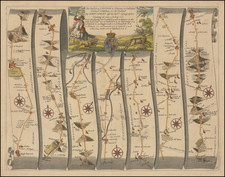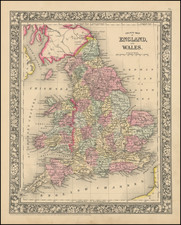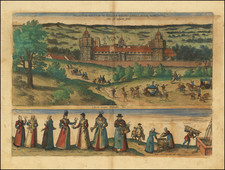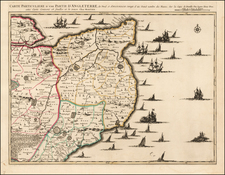Interesting map of the Saxon Heptarchy, published by Mallet in his monumental Description de L'Univers, first published in Paris in 1683.
The term "Saxon Heptarchy" refers to a period in early English history, roughly spanning the 5th to the 9th centuries, during which seven kingdoms - Wessex, Essex, Sussex, Kent, East Anglia, Mercia, and Northumbria - emerged in what is now England following the retreat of Roman authority. These kingdoms, predominantly settled and ruled by Anglo-Saxon tribes, were characterized by their distinct cultures, legal systems, and dialects. The concept of the Heptarchy is more a historiographical construct than a precise reflection of the era's political landscape, as the power dynamics, territorial boundaries, and number of significant polities were in constant flux. However, this framework provides a useful means for understanding the early stages of English medieval history, marked by a tapestry of warfare, diplomacy, and cultural exchange.
Historically, the significance of the Saxon Heptarchy extends beyond mere inter-kingdom conflicts and alliances. This era laid the foundational ethnic, cultural, and linguistic bedrock of early medieval England. It was during this time that the initial spread of Christianity took place, significantly influencing the social and political structures of the Anglo-Saxon kingdoms. The period is crucial for understanding the subsequent unification processes that would eventually lead to the formation of a single English kingdom under the Wessex dynasty.
Alain Mannesson Mallet (1630-1706) was a French mapmaker and engineer who served in the armies of Louis XIV. After rising through the ranks, Mallet was appointed as Inspector of Fortifications, a job which also required mathematical skills and which made him a competent military engineer. Eventually, he joined the court of Louis XIV at Versailles, where he taught math and focused on writing.
Mallet is best known for his Description de L’Univers, first published in 1683, in five volumes. A wide-ranging geographical work, the Description included textual descriptions of the countries of the world, as well as maps of the celestial sky and the ancient and modern worlds. The Description continued to be published until the early eighteenth century. He also published a work in three volumes on warfare (1684) and a primer on geometry (1702).










![[ Chatham Harbor ] A Geometrical Plan & North West Elevation of his Majesty's Dock-Yard at Chatham, with ye village of Brompton adjacent.](https://storage.googleapis.com/raremaps/img/small/84698.jpg)



![(Second World War - The Blitz) Ubersichtskarte Grossbritannien und Irland [General map of Great Britain and Ireland]](https://storage.googleapis.com/raremaps/img/small/89057.jpg)